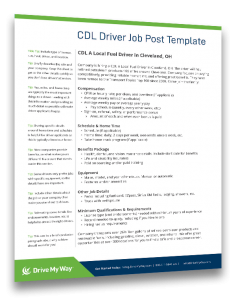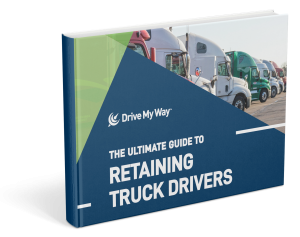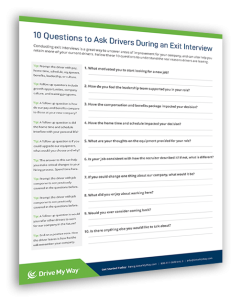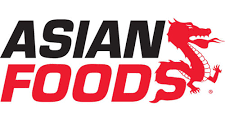
Truck driving is a career that is not for the faint of heart. With long hours, physical demands, and the stress of working on the road, it goes without saying that truck drivers are some of the hardest workers out there. Not only is truck driving a strenuous job, but it is also a vital one. Without the dedication of America’s truck drivers, communities across the nation would go without necessary goods; from food to clothing, truck drivers are the cornerstone of transportation in this country. For this and many other reasons, we honor our truck drivers every year during National Truck Driver Appreciation Week.
History of National Truck Driver Appreciation Week
According to the American Trucking Associations (ATA), National Truck Driver Appreciation Week is a time for Americans to show gratitude to the millions of truck drivers who make sure goods are delivered to communities across the country. This program is an annual celebration that was started by the ATA in 1988 to recognize the vital role that truck drivers play in our supply chain and economy. To put it into perspective, at least 80% of communities throughout the U.S. rely on trucks to meet their freight transportation needs. This year, National Truck Driver Appreciation Week is September 10th –16th.
Best Ways to Celebrate Your Drivers During National Truck Driver Appreciation Week
There are many wonderful appreciation ideas for celebrating your drivers during National Truck Driver Appreciation Week. From bonuses to free lunches, these gestures go a long way in showing gratitude for your drivers. Some other creative ways to celebrate your drivers include:
Ask Your Drivers: One of the best ways to celebrate your team is asking for their feedback. By having an open dialogue with your drivers, you can see the areas where the company is excelling, and the areas that could use improvement. Perhaps your drivers would benefit from the use of new technology. Do you have a bonus structure in place? Even new seats in their trucks could go a long way in showing that you value your drivers’ well-being. By asking them what would make their job more comfortable, you not only are able to show appreciation, but also demonstrate that their opinion has an impact on the company as a whole.
Survival Kits: Way cooler than a gift basket, survival kits are a creative way to put together items that your drivers can use while they are on a haul. From healthy snacks to new tech, a truck driver survival kit is a fun gift that shows your team that you value their hard work and are dedicated to providing them with tools they need to continue to do their job well.
Family Time: Truck driving is demanding physically, but it is also draining emotionally. Many drivers spend weeks at a time away from their families, which is tough. A great way to show appreciation for drivers is to include extra time with family. Whether that is an extra day off, family company events, or the option to bring your family on the road, these gestures mean the world to drivers. This story, shared on Healthy Trucking of America, highlights the ups and downs of having a parent that is an OTR driver. By ensuring that your drivers have a healthy work-life balance and plenty of time to spend with family, you can not only increase driver retention, but show your team that you genuinely care about them having quality time to spend with their spouses and children.
Showing Gratitude for Your Drivers Year-Round
While showing your gratitude to your drivers during National Truck Driver Appreciation Week is a wonderful gesture, year-round appreciation is an important tool for companies to invest time and energy into, so they can increase driver retention. For additional truck driver appreciation ideas, download our Quick Guide to Truck Driver Appreciation.
What are some ways your company shows appreciation for your drivers during National Truck Driver Appreciation Week, or year-round? Connect with us on Facebook, LinkedIn, or Instagram; we would love to hear from you!



 If you’re dealing with high application abandonment, try putting yourself in a driver’s shoes. Most drivers don’t want to spend their limited free time filling out lengthy and complex applications. In fact, this is usually
If you’re dealing with high application abandonment, try putting yourself in a driver’s shoes. Most drivers don’t want to spend their limited free time filling out lengthy and complex applications. In fact, this is usually  Since drivers spend most of their time on the road, they mainly search for and apply to jobs using their smartphones. In this mobile-first world, recruiters and fleet managers need to make sure they’re able to communicate and interface with drivers this way. Otherwise, you risk a large number of drivers abandoning your application.
Since drivers spend most of their time on the road, they mainly search for and apply to jobs using their smartphones. In this mobile-first world, recruiters and fleet managers need to make sure they’re able to communicate and interface with drivers this way. Otherwise, you risk a large number of drivers abandoning your application. While you, as a recruiter can create what you think is the most efficient, painless, and all-around great application experience, you won’t really know how it is until drivers start applying. Even when they do start, it can be hard to gauge what’s working and what’s not since gathering data around job application abandonment can prove to be difficult.
While you, as a recruiter can create what you think is the most efficient, painless, and all-around great application experience, you won’t really know how it is until drivers start applying. Even when they do start, it can be hard to gauge what’s working and what’s not since gathering data around job application abandonment can prove to be difficult.


 When speaking with driver candidates, be sure you’re an expert on your company and the particulars of the job. Know what the day-to-day will look like and give honest answers. Don’t sugarcoat things if you know that your company might not have the world’s best benefits or if the pay might not be at the top of the scale.
When speaking with driver candidates, be sure you’re an expert on your company and the particulars of the job. Know what the day-to-day will look like and give honest answers. Don’t sugarcoat things if you know that your company might not have the world’s best benefits or if the pay might not be at the top of the scale.  This may sound obvious, but you’d be surprised how many recruiting departments lack a cohesive plan for how to bring drivers into their organization. While each hiring plan will vary from carrier to carrier, all of them should have two things in common. They should be measurable and repeatable.
This may sound obvious, but you’d be surprised how many recruiting departments lack a cohesive plan for how to bring drivers into their organization. While each hiring plan will vary from carrier to carrier, all of them should have two things in common. They should be measurable and repeatable. Comprehensive CDL Recruitment Solutions
Comprehensive CDL Recruitment Solutions
 Almost every carrier has some sort of Facebook presence by now. Whether that Facebook presence is actively helping you reach drivers is the bigger question.
Almost every carrier has some sort of Facebook presence by now. Whether that Facebook presence is actively helping you reach drivers is the bigger question. 
 The most important part of strong communication with drivers is good listening. This means you actually take time and effort to hear drivers’ concerns and then address them. Good listening isn’t just reactive. Don’t just wait for drivers to come to you with their concerns. Be curious enough to inquire about their needs and questions.
The most important part of strong communication with drivers is good listening. This means you actually take time and effort to hear drivers’ concerns and then address them. Good listening isn’t just reactive. Don’t just wait for drivers to come to you with their concerns. Be curious enough to inquire about their needs and questions. Sometimes, the medium is the message. Choosing the proper communication method can make the difference between having successful conversations with drivers or leaving them frustrated. Some issues are too long or complicated to discuss over text or email. Calling drivers’ cell phones is the most popular way to communicate with drivers for a good reason.
Sometimes, the medium is the message. Choosing the proper communication method can make the difference between having successful conversations with drivers or leaving them frustrated. Some issues are too long or complicated to discuss over text or email. Calling drivers’ cell phones is the most popular way to communicate with drivers for a good reason.
 This one cannot be overstated. None of your communication strategies and methods are going to work if drivers don’t feel that you’re treating them with respect.
This one cannot be overstated. None of your communication strategies and methods are going to work if drivers don’t feel that you’re treating them with respect.



 It’s not breaking news that print media is on the decline. While ads in newspapers and magazines may have been the primary advertising channel decades ago, readership has gone down significantly.
It’s not breaking news that print media is on the decline. While ads in newspapers and magazines may have been the primary advertising channel decades ago, readership has gone down significantly.  You’ve seen these ads everywhere: Ones with 20-30 bullets listing out every facet and minute detail of a job. But the more information available for prospective hires, the better, right? Think again. In that very early stage of the job search, driver candidates are usually just looking for a few pieces of key information so they can decide if they want to learn more about the position.
You’ve seen these ads everywhere: Ones with 20-30 bullets listing out every facet and minute detail of a job. But the more information available for prospective hires, the better, right? Think again. In that very early stage of the job search, driver candidates are usually just looking for a few pieces of key information so they can decide if they want to learn more about the position.  To simply call social media popular anymore is a gross understatement. It’s become so entwined with people’s lives that we almost can’t imagine life without it. This is why it’s important for carriers who are looking to reach more drivers through their job ads to build up a presence on these social media sites.
To simply call social media popular anymore is a gross understatement. It’s become so entwined with people’s lives that we almost can’t imagine life without it. This is why it’s important for carriers who are looking to reach more drivers through their job ads to build up a presence on these social media sites.  Like most everyone, truck drivers are all over social media. It’s where they connect with other drivers, share tips for being on the road, and discuss current happenings. It’s also where they look for jobs and research carriers.
Like most everyone, truck drivers are all over social media. It’s where they connect with other drivers, share tips for being on the road, and discuss current happenings. It’s also where they look for jobs and research carriers. 



 At this point, the trucking shortage has become the normal state of things. It’s widely understood that the demand for truck drivers is much higher than the supply of drivers looking for jobs. Because of this, trucking companies are doing whatever they can to keep current drivers happy and bring new ones onboard. This includes pay increases, newer trucks and equipment, increased home time, and more.
At this point, the trucking shortage has become the normal state of things. It’s widely understood that the demand for truck drivers is much higher than the supply of drivers looking for jobs. Because of this, trucking companies are doing whatever they can to keep current drivers happy and bring new ones onboard. This includes pay increases, newer trucks and equipment, increased home time, and more.




